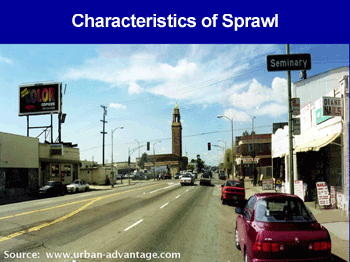Characteristics of Sprawl
Sprawl is described as low-density, automobile-dependent development outside compact urban and village centers, along highways and in rural countryside (Planners Web ![]() 2001). However, sprawl is also described within a spatio-temporal context, in which the rate of increase of urban land in comparison to non-agricultural or non-natural uses exceeds the rate of population growth.
2001). However, sprawl is also described within a spatio-temporal context, in which the rate of increase of urban land in comparison to non-agricultural or non-natural uses exceeds the rate of population growth.
Characteristics of sprawl include the following:
- Excessive land consumption and fragmented open space
- Low population densities
- Lack of travel choices
- Higher service and infrastructure costs
- Lack of choice in housing types and prices
- Geographical separation of everyday functions
- Loss of rural character and agricultural land
- Visual clutter and scattered appearance
- Commercial buildings surrounded by large parking lots
Sprawl contributes greatly to changes in the hydrologic balance of watersheds because sprawling development paves over natural land with impervious pavement and concrete. Water behaves differently over paved surfaces, changing the nature of the watershed in terms of both water quality and water quantity.
![[logo] US EPA](https://www.epa.gov/epafiles/images/logo_epaseal.gif)

